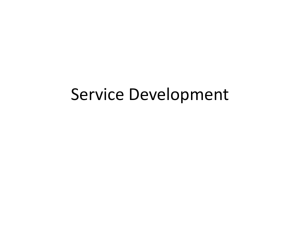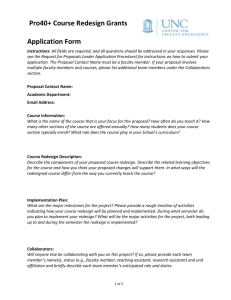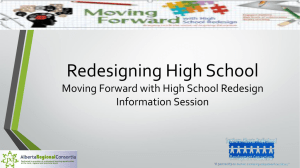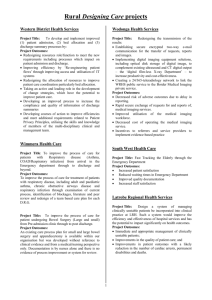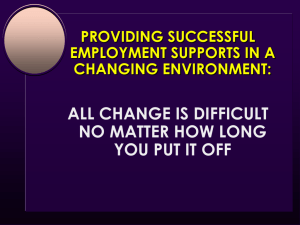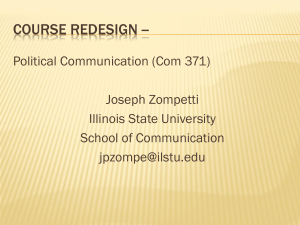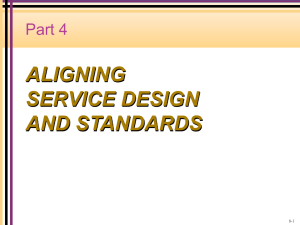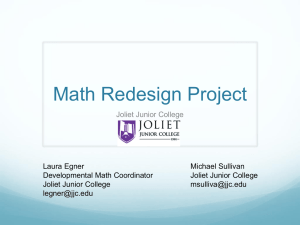File
advertisement
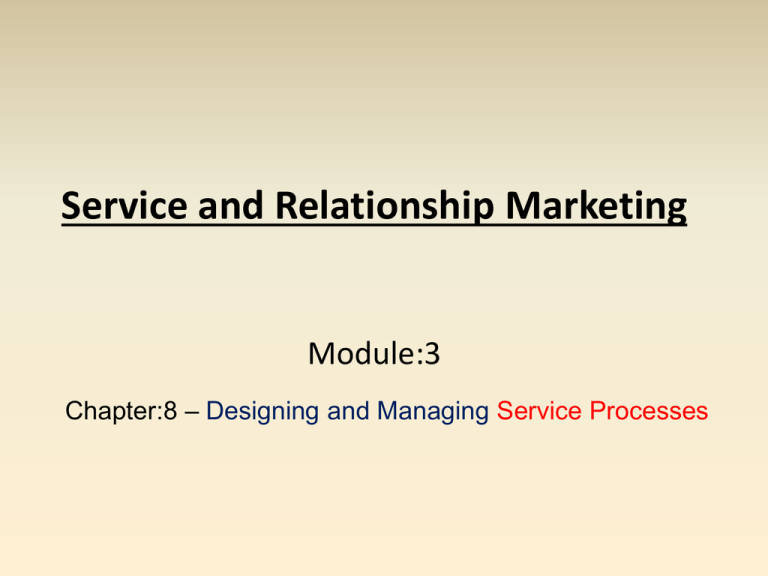
Service and Relationship Marketing Module:3 Chapter:8 – Designing and Managing Service Processes Flowcharting Customer Service Processes Flowcharting Service Delivery Helps to Clarify Product Elements • Technique for displaying the nature and sequence of the different steps in delivery service to customers • Offers way to understand total customer service experience • Shows how nature of customer involvement with service organizations varies by type of service: – – – – People processing Possession processing Mental Stimulus processing Information processing Flowcharts for People and Possession Processing Services Flowcharts for Mental Stimulus and Information Processing Services Blueprinting Services to Create Valued Experiences and Productive Operations Developing a Blueprint • Developing a Blueprint – Identify key activities in creating and delivering service – Define “big picture” before “drilling down” to obtain a higher level of detail • Advantages of Blueprinting – Distinguish between “frontstage” and “backstage” – Clarify interactions and support by backstage activities and systems – Identify potential fail points; take preventive measures; prepare contingency – Pinpoint stages where customers commonly have to wait Key Components of a Service Blueprint Define standards for frontstage activities Specify physical evidence Identify principal customer actions Line of visibility Frontstage actions by frontline personnel Line of interaction Backstage actions by customer contact personnel Support processes involving other personnel Support processes involving IT Objectives: Identify fail points & risks of excessive waits Set service standards Fail-proof process Blueprinting the Restaurant Experience: Act 1 Blueprinting the Restaurant Experience: A ThreeAct Performance • Act 1: Prologue and Introductory Scenes • Act 2: Delivery of Core Product – Cocktails, seating, order food and wine, wine service – Potential fail points: Menu information complete? Menu intelligible? Everything on the menu actually available? – Mistakes in transmitting information a common cause of quality failure – Customers may not only evaluate quality of food and drink, but how promptly it is served or serving staff attitudes • Act 3: The Drama Concludes – Remaining actions should move quickly and smoothly, with no surprises at the end – Customer expectations: accurate, intelligible and prompt bill, payment handled politely, guest are thanked for their patronage Improving Reliability of Processes Through Fail-Proofing • Identify fail points • Analysis of reasons for failure reveals opportunities for failure-proofing to reduce/eliminate future errors • Need fail-safe methods for both employees and customers Setting Service Standards and Targets • Service providers set standards for each step sufficiently high to satisfy and even delight customers – Include time parameters, script and prescriptions for appropriate style and demeanor – Must be expressed in ways that permit objective measurement • Performance targets – specific process and team performance targets for which staff are responsible for • Evaluated based on distinction between standards and targets Setting Service Standards and Targets • First impression is important – Affects customer’s evaluations of quality during later stages of service delivery as customer perceptions of service experiences tend to be cumulative • For low-contact service, a single failure committed front stage is relatively more serious than in a high-contact service Setting Standards and Targets for Customer Service Processes Service Attributes Service Process Indicators Service Process Standards Performance Targets 24 hours 80% of all • Responsiveness • Reliability Processing time • Competence to approve • Accessibility applications applications in 24 hours • Courtesy • Communication • Credibility Creates a Base to Define/Process • Confidentiality Define Service Measure Customer Departmental • Listening to the Quality Goals for Satisfaction Staff Service Goals customer Redesigning Service Processes Why Redesign? • Revitalizes process that has become outdated • Changes in external environment make existing practices obsolete and require redesign of underlying processes • Rusting occurs internally – Natural deterioration of internal processes; creeping bureaucracy; evolution of spurious, unofficial standards – Symptoms: • - Extensive information exchange • - Data that is not useful • - High ratio of checking control activities to value-adding activities Why Redesign? “Institutions are like steel beams—they tend to rust. What was once smooth and shiny and nice tends to become rusty.” Mitchell T. Rabkin, MD, former president of Boston’s Beth Israel Hospital Why Redesign? • Redesign aims to achieve these performance measures: – Reduced number of service failures – Reduced cycle time from customer initiation of a service process to its completion – Enhanced productivity – Increased customer satisfaction Process Redesign: Approaches and Potential Benefits Eliminating nonvalue-adding steps • Streamline front-end and back-end processes of services • Improve productivity and customer satisfaction Shifting to selfservice • Increase in productivity and service quality • Lower costs and perhaps prices • Enhance technology reputation • Differentiates company Delivering direct service • Improve convenience for customers • Productivity can be improved by eliminating expensive retail locations • Increase customer base Process Redesign: Approaches and Potential Benefits Bundling services Redesigning physical aspects of service process • Involves grouping multiple services into one offer, focusing on a well-defined customer group • A better fit to the needs of target segment • Increase productivity with customized service • Increase per capita service use • Focus on tangible elements of service process (facilities and equipment) • Increase convenience • Enhance satisfaction and productivity of frontline staff • Cultivate interest in customers
